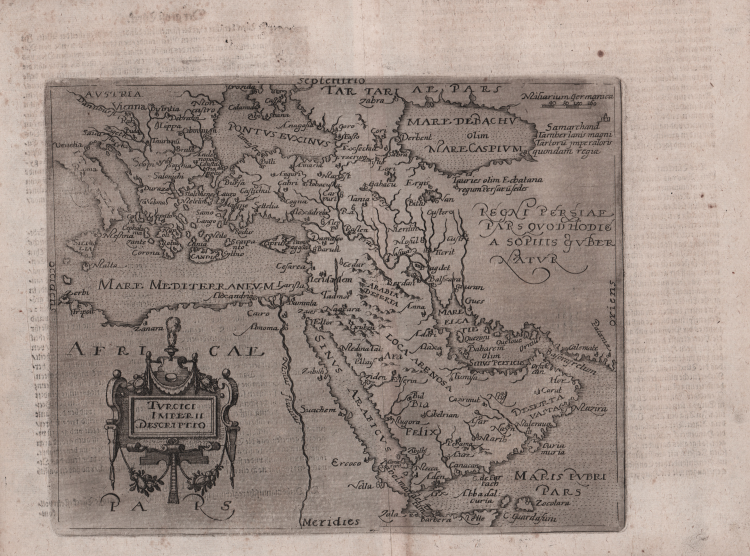



| Reference: | S26742 |
| Author | Giovanni BOTERO |
| Year: | 1596 |
| Zone: | Turkish Empire |
| Printed: | Cologne |
| Measures: | 250 x 200 mm |


| Reference: | S26742 |
| Author | Giovanni BOTERO |
| Year: | 1596 |
| Zone: | Turkish Empire |
| Printed: | Cologne |
| Measures: | 250 x 200 mm |
Etching with engraving, without signature. Beautiful impression, printed on contemporary laid paper, showing the usual center fold, small spots, otherwise in excellent condition.
The map belongs to the so-called atlases published by the Cartographic School of Cologne. For nearly half a century, Cologne was the most important mapmakers center in the XVI century, mainly due to Dutch and Flemish refugees fleeing religious persecution. Among the principal members of the School, include Quad Matthaeus, Johannes Metellus, Giovanni Botero and Frans Hogenberg, who was its founder. The atlases were often published anonymously or using pseudonyms precisely because of some political and religious problems that characterized the era. Jan Matal or Metellus, French-born Louvaine and is active in Cologne, where he took refuge just to escape persecution from the Catholic monarchs and where he died in 1597. He was one of the major cartographers of the time and, together with the Quad and Hogenberg itself as the leader of the Cologne school. Giovanni Botero (1544 - Turin 1617) was a priest, Italian philosopher and writer, author of universal relations, published a treatise on political geography for the first time in Rome in 1591 without cartographic illustrations. The work quickly became very important and studied throughout Europe, beginning almost to the study of demography. Andreas Lambert (active between 1590 and 1598) was primarily a publisher, however, some of the maps in its publications are attributed to himself, albeit in doubt. From the point of view cartographic maps are a derivation of the papers published by Abraham Ortelius in Antwerp, for the first time in 1570. The carving of the maps is attributed to Frans Hogenberg.
The present work is taken by the German edition of the works of Giovanni Botero, Theatrum oder Shawspiegel, published in 1596 by Andreas Lambert, that same year also publishes the edition with Latin text. The great rarity of the works of the school of Cologne, together with the paucity of information on these maps "secret", contributes to the charm of this important works, the cornerstone of any collection mapping.
|
Tibbets, Arabia in Early Maps, p. 57, 50; Meurer, Atlantes Colonienses Die Kolner Schule der Atlas Kartographie 1570-1610, pp. 74/78, BOT 2.
|
Giovanni BOTERO (Bene, od. Bene Vagienna, 1544 - Torino 1617).
|
Botero was sent to the Jesuit college in Palermo at the age of 15. In 1565, Botero was sent to teach philosophy and rhetoric at the Jesuit colleges in France, first in Billom, and then in Paris. He was discharged from the Jesuit order in 1580. After, he was commissioned by Bishop Carlo Borromeo of Milan as a personal assistant. When the Bishop died in 1584, Botero continued his service to the family as assistant to Carlo Borromeo's nephew, Federico. By the late 1580s, Botero had already published a few works, the his most famous: Della ragion di Stato (The Reason of State). Through the 1590s, Botero continued in the employ of Federico Borromeo, who would become Archbishop of Milan in 1595. Botero mixed in the high society of Rome and Milan in these years, and published another work for which he was to become quite well known, the Relazioni Universali. Released in four volumes between 1591 and 1598 (a fifth volume was finally published in the late nineteenth century), the 'relations' of the title referred to those of the 'universal' (Catholic) church in various parts of the world, a treatise on "The Strength of all the Powers of Europe and Asia", and even includes the Americas. The work marks the beginning of demographic studies.
|
|
Tibbets, Arabia in Early Maps, p. 57, 50; Meurer, Atlantes Colonienses Die Kolner Schule der Atlas Kartographie 1570-1610, pp. 74/78, BOT 2.
|
Giovanni BOTERO (Bene, od. Bene Vagienna, 1544 - Torino 1617).
|
Botero was sent to the Jesuit college in Palermo at the age of 15. In 1565, Botero was sent to teach philosophy and rhetoric at the Jesuit colleges in France, first in Billom, and then in Paris. He was discharged from the Jesuit order in 1580. After, he was commissioned by Bishop Carlo Borromeo of Milan as a personal assistant. When the Bishop died in 1584, Botero continued his service to the family as assistant to Carlo Borromeo's nephew, Federico. By the late 1580s, Botero had already published a few works, the his most famous: Della ragion di Stato (The Reason of State). Through the 1590s, Botero continued in the employ of Federico Borromeo, who would become Archbishop of Milan in 1595. Botero mixed in the high society of Rome and Milan in these years, and published another work for which he was to become quite well known, the Relazioni Universali. Released in four volumes between 1591 and 1598 (a fifth volume was finally published in the late nineteenth century), the 'relations' of the title referred to those of the 'universal' (Catholic) church in various parts of the world, a treatise on "The Strength of all the Powers of Europe and Asia", and even includes the Americas. The work marks the beginning of demographic studies.
|